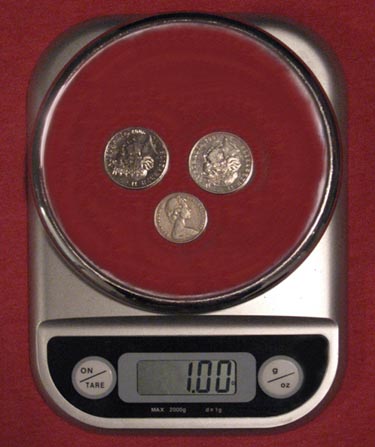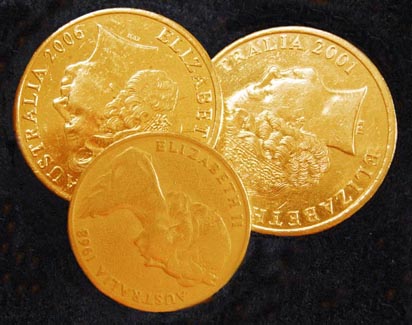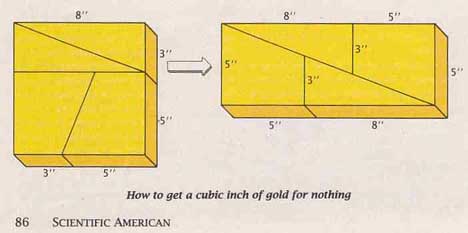
|
|
|
April 1st, 2008. How can fifty cents possibly be worth more than a thousand dollars?
Easy! As the following picture clearly shows, ...

An ounce of not-very-expensive nickel alloy -- special price for you, today, 50 cents! ... fifty Australian cents (when composed of two twenty-cent pieces and a ten-cent piece) weigh more or less exactly one ounce. Unfortunately, the cold, hard reality is that in most cases, when you take them to the bank, they're really only worth fifty cents, and even that's not worth what it once was -- cynics would tell you that they're rapidly becoming worth even less.
BUT ... imagine for just a moment that they're made from solid, primo Walhalla gold (leaving aside the specifics of the differing mass of different metals -- just work with me here) ...

The same coins made from a slightly more exotic commodity On top of all of its other attractions as one of the most beautiful metals known to man, gold is also rightfully famous as the perennial refuge -- at least, for those who have money to invest -- in times of economic uncertainty. Now, I don't know whether or not you've noticed, but it appears that times have been getting increasingly economically uncertain of late. Reflecting this, the price of gold -- which, if you don't have occasion to watch it, you might have a dim recollection of hovering somewhere around $US300, as it did for an awfully long (and apparently, economically more certain) time -- recently exceeded the previously-unthinkably stratospheric, magic threshold of $US1,000 an ounce. It only lasted briefly (as I write this, for example, it's back to somewhere around $US930), and such movements are in any case often frustratingly offset by a strangely corresponding currency movement causing an increase in the value of the Australian dollar against the American dollar, which has the effect in many cases of cancelling out such an increase in the price of gold (unless you can contrive to sell your Australian gold in American dollars and never convert them back to your home currency before spending them). However, because of that good old skyrocketing resources boom that can happen sometimes when you sell all the minerals you can excavate to a booming China as fast as you can dig them out of the ground, while America coincidentally starts to get a bit soggy around the sub-prime mortgage area, the value of the Australian dollar has, it's true, maintained a steady upward march to approach parity -- in other words, to be equal to the value of the American dollar -- and may even eventually exceed it. It isn't the purpose of this item to canvass where, when or even whether that might happen, or to try to anticipate where that might lead if it did.
Despite all that, however, when you value your fifty-cents-weight of gold in Australian dollars at the prevailing exchange rate, taken at the mid-point of each month for the past few years, you get a track that follows the yellow line in the graph below. And as you'll see from that graph, an ounce of gold has been worth more than $AU1,000 since January this year, when measured at the mid-point of each month. On March 17th of this year, with the price of gold at $US1,010.30 and the $AU buying $US.9435, it equated to something like $AU1,070.80 per ounce. And leaving aside daily fluctuations, that amounts to something like a 90% increase in its value over the course of the last three years. How easily can you think of anything else that's seen such an appreciation in its value in that time? (No, sorry, petrol doesn't count ...).
And even if our exchange rate were to slip against the American dollar, the gold that we extract here just increases its value in Australian dollars, as long as its price (in $US) remains relatively steady. And if its price increases, so much the better still. (Only problem is, there's no warning bell that goes off, just beforehand, if the third option should materialize, and it turns and heads seriously south ....).
It's interesting to reflect on how many countries you'd be able to buy with today's proceeds of the 55 tonnes of gold that were extracted during Walhalla's heyday just from the one mine on Cohen's Reef that gave the town its name. That's an awful lot of ounces.
Is it any wonder, then, that reviving some of the long-abandoned Walhalla mining prospects is coming to look like an increasingly attractive proposition? And that people who drop by the township these days seem more intent than ever on "just kicking over a rock or two" in case there's something valuable hidden underneath it, and just waiting to be revealed?
(So maybe we exaggerated just a little bit in claiming that fifty cents could be worth more than $1000 -- there's always Professor Lipof's matter fabricator, described below ...) A topical theoremToday of all days, it's perhaps more than ever appropriate to once again recognize the pioneering (not to say "ground-breaking") work of Professor Arlo Lipof, first reported in an article by A K Dewdney on p.86 of "Scientific American" magazine on this very day in 1989.Dewdney's article (and the following illustration taken from the "Computer Recreations" column of that magazine) showed incontrovertible proof of Lipof's work, derived from the famous Banach Tarski mathematical paradox, detailing how it might be possible to disassemble and reconfigure any object -- say, a lump of gold, even! -- from 64 arbitrary units of cubic measurement (say, 8 x 8 x 1 cm) to 65 units of cubic measurement (13 x 5 x 1 cm), thereby generating a seemingly-miraculous increase of almost 1.6% in the object's mass! A small gain, true, but one that would seem to be repetitively reproducible, without an apparent limit.

Arlo Lipof's matter fabricator (from "Scientific American", April, 1989, p 86) I'm somewhat surprised that not only did the world never beat a path to Professor Lipof's door in honour of his work, but in fact, he seems subsequently to have faded into complete obscurity ...
Wally Webster
|
Back |
| Home | Back |
|
|
Send your questions, suggestions and
comments about this web site to info@walhalla.org.au.. |
This page last changed on 27/8/17. |